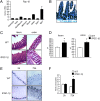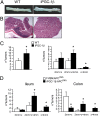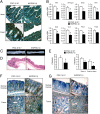PGC-1β promotes enterocyte lifespan and tumorigenesis in the intestine
- PMID: 25288742
- PMCID: PMC4210309
- DOI: 10.1073/pnas.1415279111
PGC-1β promotes enterocyte lifespan and tumorigenesis in the intestine
Abstract
The mucosa of the small intestine is renewed completely every 3-5 d throughout the entire lifetime by small populations of adult stem cells that are believed to reside in the bottom of the crypts and to migrate and differentiate into all the different populations of intestinal cells. When the cells reach the apex of the villi and are fully differentiated, they undergo cell death and are shed into the lumen. Reactive oxygen species (ROS) production is proportional to the electron transfer activity of the mitochondrial respiration chain. ROS homeostasis is maintained to control cell death and is finely tuned by an inducible antioxidant program. Here we show that peroxisome proliferator-activated receptor-γ coactivator-1β (PGC-1β) is highly expressed in the intestinal epithelium and possesses dual activity, stimulating mitochondrial biogenesis and oxygen consumption while inducing antioxidant enzymes. To study the role of PGC-1β gain and loss of function in the gut, we generated both intestinal-specific PGC-1β transgenic and PGC-1β knockout mice. Mice overexpressing PGC-1β present a peculiar intestinal morphology with very long villi resulting from increased enterocyte lifespan and also demonstrate greater tumor susceptibility, with increased tumor number and size when exposed to carcinogens. PGC-1β knockout mice are protected from carcinogenesis. We show that PGC-1β triggers mitochondrial respiration while protecting enterocytes from ROS-driven macromolecule damage and consequent apoptosis in both normal and dysplastic mucosa. Therefore, PGC-1β in the gut acts as an adaptive self-point regulator, capable of providing a balance between enhanced mitochondrial activity and protection from increased ROS production.
Keywords: colon cancer; gene expression; molecular pathology; nuclear receptors.
Conflict of interest statement
The authors declare no conflict of interest.
Figures







References
-
- St-Pierre J, et al. Suppression of reactive oxygen species and neurodegeneration by the PGC-1 transcriptional coactivators. Cell. 2006;127(2):397–408. - PubMed
-
- Wu Z, et al. Mechanisms controlling mitochondrial biogenesis and respiration through the thermogenic coactivator PGC-1. Cell. 1999;98(1):115–124. - PubMed
-
- Puigserver P, et al. A cold-inducible coactivator of nuclear receptors linked to adaptive thermogenesis. Cell. 1998;92(6):829–839. - PubMed
Publication types
MeSH terms
Substances
Associated data
- Actions
LinkOut - more resources
Full Text Sources
Other Literature Sources
Molecular Biology Databases
Miscellaneous

